Speed of Light
Somewhere in outer space, billions of light years from Earth, the original light associated with the Big Bang of the universe is blazing new ground as it continues moving outward. In stark contrast, another form of electromagnetic radiation originating on the Earth, radio waves from the inaugural live episode of The Lucy Show are broadcasting a premier somewhere in deep space, although greatly reduced in amplitude.
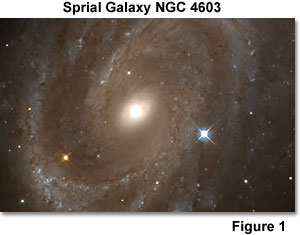
The basic concept behind both events involves the speed of light (and all other forms of electromagnetic radiation), which scientists have thoroughly examined, and is now expressed as a constant value denoted in equations by the symbol c. Not truly a constant, but rather the maximum speed in a vacuum, the speed of light, which is almost 300,000 kilometers per second, can be manipulated by changing media or with quantum interference.
Light traveling in a uniform substance, or medium, propagates in a straight line at a relatively constant speed, unless it is refracted, reflected, diffracted, or perturbed in some other manner. This well-established scientific fact is not a product of the Atomic Age or even the Renaissance, but was originally promoted by the ancient Greek scholar, Euclid, somewhere around 350 BC in his landmark treatise Optica. However, the intensity of light (and other electromagnetic radiation) is inversely proportional to the square of the distance traveled. Thus, after light has traveled twice a given distance, the intensity drops by a factor of four.
When light traveling through the air enters a different medium, such as glass or water, the speed and wavelength of light are reduced (see Figure 2), although the frequency remains unaltered. Light travels at approximately 300,000 kilometers per second in a vacuum, which has a refractive index of 1.0, but it slows down to 225,000 kilometers per second in water (refractive index of 1.3; see Figure 2) and 200,000 kilometers per second in glass (refractive index of 1.5). In diamond, with a rather high refractive index of 2.4, the speed of light is reduced to a relative crawl (125,000 kilometers per second), being about 60 percent less than its maximum speed in a vacuum.
Because of the enormous journeys that light travels in outer space between galaxies (see Figure 1) and within the Milky Way, the expanse between stars is measured not in kilometers, but rather light-years, the distance light would travel in a year. A light-year equals 9.5 trillion kilometers or about 5.9 trillion miles. The distance from Earth to the next nearest star beyond our sun, Proxima Centauri, is approximately 4.24 light-years. By comparison, the Milky Way galaxy is estimated to be about 150,000 light-years in diameter, and the distance to the Andromeda galaxy is approximately 2.21 million light-years. This means that light leaving the Andromeda galaxy 2.21 million years ago is just arriving at Earth, unless it was waylaid by reflecting celestial bodies or refracting debris.
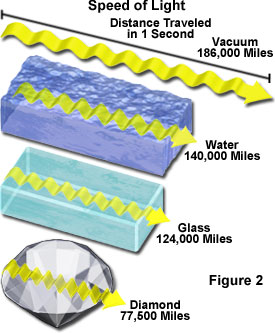
When astronomers gaze into the night skies, they are observing a mixture of real time, the recent past, and ancient history. For example, during the period that pioneering Babylonians, Arab astrologers, and Greek astronomers described the stellar constellations, Scorpius (Scorpio to astrologers) still had the whiptail of a scorpion. The tail star and others in this constellation had appeared as novae in the skies between 500 and 1000 BC, but are no longer visible to today's stargazers. Although some of the stars that are observed in the night skies of Earth have long since perished, the light waves that carry their images are still reaching human eyes and telescopes. In effect, the light from their destruction (and the darkness of their absence) has not yet crossed the enormous distances of deep space because of insufficient time.
Empedocles of Acragas, who lived around 450 BC, was one of the first recorded philosophers to speculate that light traveled with a finite velocity. Almost a millennium later, around 525 AD, Roman scholar and mathematician Anicius Boethius attempted to document the speed of light, but after being accused of treason and sorcery, was decapitated for his scientific endeavors. Since the earliest application of black powder for fireworks and signals by the Chinese, man has wondered about the speed of light. With the flash of light and color preceding the explosive sound by several seconds, it did not require a serious calculation to realize that the speed of light obviously exceeded the speed of sound.
| Interactive Java Tutorial | |||||||||||
|
|||||||||||
The Chinese secrets behind explosives made their way to the West during the middle of the thirteenth century, and with them, came questions about the speed of light. Prior to this period, other investigators must have considered the flash of lightning followed later by the clap of thunder, typical of a thunderstorm, but offered no plausible scientific explanations about the nature of the delay. The Arabic scholar Alhazen was the first serious optical scientist to suggest (around 1000 AD) that light had a finite speed, and by 1250 AD, British optics pioneer Roger Bacon wrote that the speed of light was finite, although very rapid. Still, the widely held opinion by a majority of scientists during this period was that the speed of light is infinite and could not be measured.
In 1572, the famous Danish astronomer Tycho Brahe was the first to describe a supernova, which occurred in the constellation Cassiopeia. After watching a "new star" suddenly appear in the sky, slowly intensify in brightness, and then fade from view over an 18-month period, the astronomer was mystified, but intrigued. These novel celestial visions drove Brahe and his contemporaries to question the widely held notion of a perfect and unchanging universe having an infinite speed of light. The belief that light has infinite speed was hard to displace, although a few scientists were beginning to question the speed of light in the sixteenth century. As late as 1604, the German physicist Johannes Kepler speculated that the speed of light was instantaneous. He added in his published notes that the vacuum of space did not slow the speed of light down, hampering, to a limited degree, the quest by his contemporaries for the ether that supposedly filled space and carried the light.
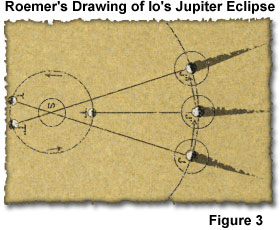
Shortly after the invention and some relatively crude refinements to the telescope, Danish astronomer Ole Roemer (in 1676) was the first scientist to make a rigorous attempt to estimate the speed of light. By studying Jupiter's moon Io and its frequent eclipses, Roemer was able to predict the periodicity of an eclipse period for the moon (Figure 3). However, after several months, he noticed that his predictions were slowly becoming less accurate by progressively longer time intervals, reaching a maximum error of about 22 minutes (a rather large discrepancy, considering how far light travels in that time span). Then, just as oddly, his predictions again became more accurate over several months, with the cycle repeating itself. Working at the Paris Observatory, Roemer soon realized that the observed differences were caused by variations in the distance between the Earth and Jupiter, due to orbital pathways of the planets. As Jupiter moved away from the Earth, light had a longer distance to travel, taking additional time to reach the Earth. Applying the relatively inaccurate calculations for the distances between Earth and Jupiter available during the period, Roemer was able to estimate the speed of light at about 137,000 miles (or 220,000 kilometers) per second. Figure 3 illustrates a reproduction of the original drawings by Roemer delineating his methodology utilized to determine the speed of light.
Roemer's work stirred the scientific community, and many investigators began to reconsider their speculations about the infinite speed of light. Sir Isaac Newton, for example, wrote in his landmark 1687 treatise Philosophiae Naturalis Prinicipia Mathematica (Mathematical Principles of Natural Philosophy), "For it is now certain from the phenomena of Jupiter's satellites, confirmed by the observations of different astronomers, that light is propagated in succession and requires about seven or eight minutes to travel from the sun to the earth", which is actually a remarkably close estimate for the correct speed of light. Newton's respected opinion and widespread reputation was instrumental in jump-starting the Scientific Revolution, and helped launch new research by scientists who now endorsed light's speed as finite.
The next in line to provide a useful estimate of the speed of light was the British physicist James Bradley. In 1728, a year after Newton's death, Bradley estimated the speed of light in a vacuum to be approximately 301,000 kilometers per second, using stellar aberrations. These phenomena are manifested by an apparent variation in the position of stars due to the motion of the Earth around the sun. The degree of stellar aberration can be determined from the ratio of the Earth's orbital speed to the speed of light. By measuring the stellar aberration angle and applying that data to the orbital speed of the Earth, Bradley was able to arrive at a remarkably accurate estimate.
In 1834, Sir Charles Wheatstone, inventor of the kaleidoscope and a pioneer in the science of sound, attempted to measure the speed of electricity. Wheatstone invented a device that utilized rotating mirrors and capacitative discharge through a Leyden jar to generate and clock the movement of sparks through almost eight miles of wire. Unfortunately, his calculations (and perhaps his instrumentation) were in error to such a degree that Wheatstone estimated the velocity of electricity at 288,000 miles per second, a mistake that led him to believe that electricity traveled faster than light. Wheatstone's research was later expanded upon by French scientist Dominique François Jean Arago. Although he failed to complete his work before his eyesight failed in 1850, Arago correctly postulated that light traveled slower in water than air.
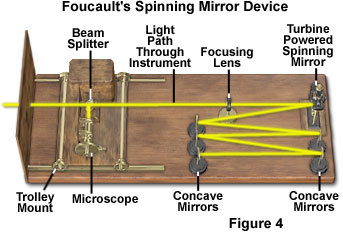
Meanwhile in France, rival scientists Armand Fizeau and Jean-Bernard-Leon Foucault independently attempted to measure the speed of light, without relying on celestial events, by taking advantage of Arago's discoveries and expanding on Wheatstone's rotating mirror instrument design. In 1849, Fizeau engineered a device that flashed a light beam through a toothed wheel (instead of a rotating mirror), and then onto a fixed mirror positioned at a distance of 5.5 miles away. By rotating the wheel at a rapid rate, he was able to steer the beam through a gap between two of the teeth on the outward journey and catch reflected rays in the neighboring gap on the way back. Armed with the wheel speed and distance traveled by the pulsed light, Fizeau was able to calculate the speed of light. He also discovered that light travels faster in air than in water (confirming Arago's hypothesis), a fact that fellow countryman Foucault later confirmed through experimentation.
Foucault employed a rapidly rotating mirror driven by a compressed air turbine to measure the speed of light. In his apparatus (see Figure 4), a narrow beam of light is passed through an aperture and then through a glass window (acting also as a beamsplitter) with a finely graduated scale before impacting on the rapidly spinning mirror. Light reflected from the spinning mirror is directed through a battery of stationary mirrors in a zigzag pattern designed to increase the path length of the instrument to about 20 meters without a corresponding increase in size. In the amount of time it took the light to reflect through the series of mirrors and return to the rotating mirror, a slight shift in the mirror position had occurred. Subsequently, light reflected from the shifted position of the spinning mirror follows a new pathway back to the source and into a microscope mounted on the instrument. The tiny shift in light could be seen through the microscope and recorded. By analysis of the data collected from his experiment, Foucault was able to calculate the speed of light as 298,000 kilometers per second (approximately 185,000 miles per second).
The light path in Foucault's device was short enough to be utilized in the measurement of light speeds through media other than air. He discovered that the speed of light in water or glass was only about two-thirds of the value in air, and he also concluded that the speed of light through a given medium is inversely proportional to the refractive index. This remarkable result is consistent with the predictions about light behavior developed hundreds of years earlier from the wave theory of light propagation.
Following Foucault's lead, a Polish-born American physicist named Albert A. Michelson attempted to increase the accuracy of the method, and successfully measured the speed of light in 1878 with a more sophisticated version of the apparatus along a 2,000-foot wall lining the banks of Maryland's Severn River. Investing in high quality lenses and mirrors to focus and reflect a beam of light over a much longer pathway than the one utilized by Foucault, Michelson calculated a final result of 186,355 miles per second (299,909 kilometers per second), allowing for a possible error of about 30 miles per second. Due to the increased sophistication of his experimental design, the accuracy of Michelson's measurement was over 20 times greater than Foucault's.
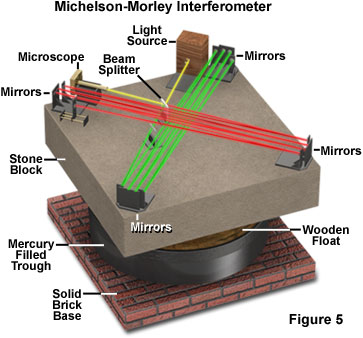
During the late 1800s it was still believed by most scientists that light propagates through space utilizing a carrier medium termed the ether. Michelson teamed with scientist Edward Morley in 1887 to devise an experimental method for detecting the ether by observing relative changes in the speed of light as the Earth completed its orbit around the sun. In order to accomplish this goal, they designed an interferometer that splits a beam of light and re-directs the individual beams through two different pathways, each over 10 meters in length, using a complex array of mirrors. Michelson and Morley reasoned that if the Earth is traveling through an ether medium, the beam reflecting back and forth perpendicular to the flow of ether would have to travel farther than the beam reflecting parallel to the ether. The result would be a delay in one of the light beams that could be detected when the beams were recombined through interference.
The experimental apparatus built by Michelson and Morley was massive (see Figure 5). Mounted on a slowly rotating stone slab that was over five feet square and 14 inches thick, the instrument was further protected by an underlying pool of mercury that acted as a frictionless shock absorber to remove vibrations from the Earth. Once the slab was set into motion, achieving a top speed of 10 revolutions per hour, it took hours to reach a halt again. Light passing through a beamsplitter, and reflected by the mirror system, was examined with a microscope for interference fringes, but none were ever observed. However, Michelson utilized his interferometer to accurately determine the speed of light at 186,320 miles per second (299,853 kilometers per second), a value that stood as the standard for the next 25 years. The failure to detect a change in the speed of light by the Michelson-Morley experiment set in motion the beginnings of an end to the ether controversy, which was finally laid to rest by the theories of Albert Einstein in the early twentieth century.
In 1905, Einstein published his Special Theory of Relativity followed by the General Theory of Relativity in 1915. The first theory related to the movement of objects at constant velocity relative to one another, while the second focused on acceleration and its links with gravity. Because they challenged many long-standing hypotheses, such as Isaac Newton's law of motion, Einstein's theories were a revolutionary force in physics. The idea of relativity embodies the concept that the velocity of an object can be determined only relative to the position of the observer. As an example, a man walking inside an airliner appears to be traveling at about one mile per hour in the reference frame of the aircraft (which itself is moving at 600 miles per hour). However, to an observer on the ground, the man seems to be moving at 601 miles per hour.
Einstein assumed in his calculations that the speed of light traveling between two frames of reference remains the same for observers in both locations. Because an observer in one frame uses light to determine the position and velocity of objects in another frame, this changes the manner in which the observer can relate the position and velocity of the objects. Einstein employed this concept to derive several important formulas describing how objects in one frame of reference appear when viewed from another that is in uniform motion relative to the first. His results led to some unusual conclusions, although the effects only become noticeable when the relative velocity of an object approaches the speed of light. In summary, the major implications of Einstein's fundamental theories and his often-referenced relativity equation:
can be summarized as follows:
The length of an object decreases, relative to an observer, as the velocity of that object increases.
When a frame of reference is moving, time intervals become shorter. In other words, a space traveler moving at or near the speed of light could leave the Earth for many years, and return having experienced a time lapse of only a few months.
The mass of a moving object increases with its velocity, and as the velocity approaches the speed of light, the mass approaches infinity. For this reason, it is widely believed that travel faster than the speed of light is impossible, because an infinite amount of energy would be required to accelerate an infinite mass.
Although Einstein's theory affected the entire world of physics, it had particularly important implications for those scientists who were studying light. The theory explained why the Michelson-Morley experiment failed to produce the expected results, discouraging further serious scientific investigations into the nature of ether as a carrier medium. It also demonstrated that nothing can move faster than the speed of light in a vacuum, and that this speed is a constant and unchanging value. Meanwhile, experimental scientists continued to apply increasingly sophisticated instruments to zero in on a correct value for the speed of light and reduce the error in its measurement.
Measurements of the Speed of Light
|
||||||||||||||||||||||||||||||||||||||||||||||||||||||||||||||||||||||||||||||||||||||||||||||||||
Table 1
During the late nineteenth century, advances in radio and microwave technology provided novel approaches for measuring the speed of light. In 1888, more than 200 years after Roemer's pioneering celestial observations, German physicist Heinrich Rudolf Hertz measured the speed of radio waves. Hertz arrived at a value near 300,000 kilometers per second, confirming James Clerk Maxwell's theory that radio waves and light were both forms of electromagnetic radiation. Additional proof was gathered during the 1940s and 1950s, when British physicists Keith Davy Froome and Louis Essen employed radio and microwaves, respectively, to more precisely measure the speed of electromagnetic radiation.
Maxwell is also credited with defining the speed of light and other forms of electromagnetic radiation, not through measurement, but by mathematical deduction. During his research attempts to find a link between electricity and magnetism, Maxwell theorized that a changing electrical field produces a magnetic field, the reverse corollary of Faraday's law. He proposed that electromagnetic waves are composed of combined oscillating electric and magnetic waves, and calculated the velocity of these waves through space as:
where e is the permitivity and m is the permeability of free space, two constants that can be measured with a relatively high degree of accuracy. The result is a value that closely approximates the measured speed of light.
In 1891, continuing his studies on the speed of light and astronomy, Michelson created a large-scale interferometer using the refracting telescope at the Lick Observatory in California. His observations were based on the delay in the arrival time of light when viewing distant objects, such as stars, which can be quantitatively analyzed to measure both the size of celestial bodies and the speed of light. Almost 30 years later, Michelson moved his experiments to the Mount Wilson Observatory, and applied the same techniques to the 100-inch telescope, the world's largest at the time.
By incorporating an octagonal rotating mirror into his experimental design, Michelson arrived at a value of 299,845 kilometers per second for the speed of light. Although Michelson died before completing his experiments, his co-worker at Mount Wilson, Francis G. Pease, continued to employ the innovative technique to conduct research into the 1930s. Using a modified interferometer, Pease made numerous measurements over several years and finally determined that the correct value for the speed of light is 299,774 kilometers per second, the closest measurement achieved to that date. Several years later, in 1941, the scientific community set a standard for the speed of light. This value, 299,773 kilometers per second, was based on a compilation from the most accurate measurements of the period. Figure 6 presents a graphical representation of light speed measurements over the past 200 years.
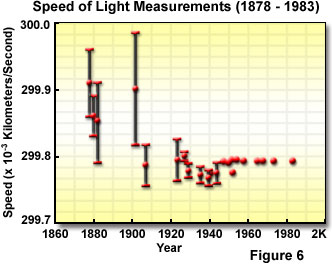
By the late 1960s, lasers were becoming stable research tools with highly defined frequencies and wavelengths. It quickly became obvious that a simultaneous measurement of frequency and wavelength would yield a very accurate value for the speed of light, similar to an experimental approach carried out by Keith Davy Froome using microwaves in 1958. Several research groups in the United States and in other countries measured the frequency of the 633-nanometer line from an iodine-stabilized helium-neon laser and obtained highly accurate results. In 1972, the National Institute of Standards and Technology employed the laser technology to measure the speed at 299,792,458 meters per second (186,282 miles per second), which ultimately resulted in the redefinition of the meter through a highly accurate estimate for the speed of light.
Starting with Roemer's 1676 breakthrough endeavors, the speed of light has been measured at least 163 times utilizing a wide variety of different techniques by more than 100 investigators (see Table 1 for a compilation of methods, investigators, and dates). As scientific methods and devices were refined, the error limits of the estimates narrowed, although the speed of light has not significantly changed since Roemer's seventeenth century calculations. Finally in 1983, more than 300 years after the first serious measurement attempt, the speed of light was defined as being 299,792.458 kilometers per second by the Seventeenth General Congress on Weights and Measures. Thus, the meter is defined as the distance light travels through a vacuum during a time interval of 1/299,792,458 seconds. In general, however, (even in many scientific calculations) the speed of light is rounded to 300,000 kilometers (or 186,000 miles) per second. Arriving at a standard value for the speed of light was important for establishing an international system of units that would enable scientists from around the world to compare their data and calculations.
There is a mild controversy over whether evidence exists that the speed of light has been slowing since the time of the Big Bang, when it may have moved significantly faster, as suggested by some investigators. Although arguments presented and countered perpetuate this debate, most scientists still contend that the speed of light is a constant. Physicists point out that the actual speed of light as measured by Roemer and his followers has not significantly changed, but rather point to a series of refinements in scientific instrumentation associated with increases in precision of the measurements utilized to establish the speed of light. Today, the distance between Jupiter and the Earth is known with a high degree of accuracy, as are the diameter of the solar system and the orbital trajectories of the planets. When researchers apply this data to rework the calculations made over the past few centuries, they derive values for the speed of light comparable to those obtained with more modern and sophisticated instrumentation.
Contributing Authors
Kenneth R. Spring - Scientific Consultant, Lusby, Maryland, 20657.
Thomas J. Fellers, Lawrence D. Zuckerman, and Michael W. Davidson - National High Magnetic Field Laboratory, 1800 East Paul Dirac Dr., The Florida State University, Tallahassee, Florida, 32310.
